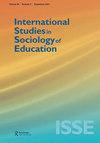教育和社会流动:可能性、生殖结构、话语和物质性
IF 1.5
Q2 EDUCATION & EDUCATIONAL RESEARCH
International Studies in Sociology of Education
Pub Date : 2021-10-02
DOI:10.1080/09620214.2021.1995778
引用次数: 0
摘要
长期以来,社会学家一直认为学校是社会中的核心机构,负责为国家公共利益做出贡献;有助于将不同的国家人口凝聚在一起的结构性粘合剂;发展为民族国家引擎提供燃料的人力资本;使年轻人融入社会结构。教育社会学家探讨了学校教育与社会再生产之间的关系,特别是社会再生产的微观和宏观过程的运作方式;在这些过程中家庭和学校之间的关系;以及学校实际上可以在多大程度上破坏这种生育趋势。2021年的最后一期将从教师、家长和学生等不同利益相关者的角度,进一步研究世界各地众多教育场所的教育、社会流动和社会再生产之间的关系。总之,这些文章提出了一系列关键问题:年轻人的教育成功与教育的空间有何关系?年轻人如何理解是什么促成了他们自己的教育成功感?跨越社会阶层界限的父母如何在家里支持这些成功?如何在不同的学校环境中培养和理解归属感、多样性和包容性?第一篇文章关注教育实践与学校设施设计之间关系的性质。Amitay和Rahav通过阐明与以色列另类高中有关的地点和教育概念,帮助发展对建筑和物理布局以及学校各个组成部分如何影响教学和学习过程的看法。通过使学校本身的位置和空间可见,并将其与教育环境的教学特征联系起来,就有可能设想出各种解放空间,以改善高危青年的教育实践,包括那些离开普通教育系统的青年。《教育社会学国际研究2021》,第30卷,第4期,359-361https://doi.org/10.1080/09620214.2021.1995778本文章由计算机程序翻译,如有差异,请以英文原文为准。
Education and social mobility: possibilities, reproductive structures, discourse and materiality
Schools have long been identified by sociologists as core institutions within society, responsible for contributing to the national, public good; contributing to the structural glue that holds together diverse national populations; developing the human capital that fuels the engines of the nation-state; and socializing young people into the structures that govern society. Sociologists of education have explored the relationship between schooling and social reproduction, particularly the ways that both micro and macro processes of social reproduction operate; the relationships between home and school in these processes; and the extent to which schools can in fact disrupt such reproductive tendencies. The final issue of 2021 is brought toget\her to further examine the relationship between education, social mobility, and social reproduction across a multitude of educational sites around the world and from the perspective of various stakeholders: Teachers, parents, and students. Collectively, the articles pose a set of key questions: How is educational success of young people related to the very spaces in which education takes place? How do young people understand what contributes to their own sense of educational success? How do parents across social class boundaries bolster those successes at home? How are belonging, diversity, and inclusion fostered and understood in different school settings? The first article focuses on the nature of the relationship between education practices and the design of school facilities. By illuminating notions of place and education as they pertain to an alternative high school in Israel, Amitay and Rahav help develop perspectives on how teaching and learning processes are affected by the architectural and physical layout, and various components of the school. By making the place and space of the school itself visible and linking it to the pedagogical characteristics of the educational environment, it becomes possible to envision the kinds of emancipatory spaces that would enable improved educational practices for at risk youth, including those that have left the general schooling system. INTERNATIONAL STUDIES IN SOCIOLOGY OF EDUCATION 2021, VOL. 30, NO. 4, 359–361 https://doi.org/10.1080/09620214.2021.1995778
求助全文
通过发布文献求助,成功后即可免费获取论文全文。
去求助
来源期刊
CiteScore
3.40
自引率
7.70%
发文量
34
期刊介绍:
International Studies in Sociology of Education is an international journal and publishes papers in the sociology of education which critically engage with theoretical and empirical issues, drawn from as wide a range of perspectives as possible. It aims to move debates forward. The journal is international in outlook and readership and receives papers from around the world. The journal publishes four issues a year; the first three are devoted to a particular theme while the fourth is an "open" issue.

 求助内容:
求助内容: 应助结果提醒方式:
应助结果提醒方式:


